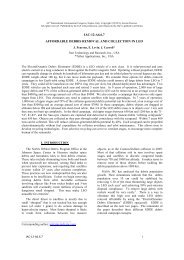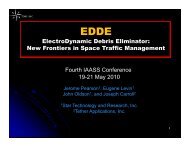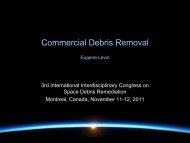The Cost of Future Collisions in LEO - Star Technology and Research
The Cost of Future Collisions in LEO - Star Technology and Research
The Cost of Future Collisions in LEO - Star Technology and Research
You also want an ePaper? Increase the reach of your titles
YUMPU automatically turns print PDFs into web optimized ePapers that Google loves.
32<br />
Fig. C2. Velocity distributions for fragments <strong>of</strong> a) Fengyun-1C, b) Cosmos-2251, c) Iridium-33.<br />
<strong>The</strong> altitude pr<strong>of</strong>iles result from the ejection <strong>of</strong> the fragments from the collision<br />
po<strong>in</strong>t. Fig. C2 shows the distributions <strong>of</strong> the ejection velocities <strong>of</strong> the fragments<br />
<strong>of</strong> the three satellites us<strong>in</strong>g 2.5-m/s b<strong>in</strong>s. <strong>The</strong>se distributions can be roughly approximated<br />
by the follow<strong>in</strong>g formula<br />
n(v) = dN v<br />
dv<br />
= N f<br />
v s<br />
·<br />
ka<br />
1 + a 2 , a = ( v<br />
v s<br />
) b<br />
, (C3)<br />
where n(v)dv is the number <strong>of</strong> fragments ejected at velocities between v <strong>and</strong> v +dv,<br />
N v is the number <strong>of</strong> fragments ejected at velocities below v, N f is the total number<br />
<strong>of</strong> fragments, v s is a characteristic velocity, b ≈ 1.6, <strong>and</strong> k ≈ 0.57 is a normalization<br />
parameter, such that<br />
∫ ∞<br />
0<br />
n(v) dv = N f .<br />
(C4)<br />
<strong>The</strong> characteristic velocity v s is approximately 50 m/s for Fengyun-1C, 35 m/s for<br />
Cosmos-2251, <strong>and</strong> 20 m/s for Iridium-33. Aga<strong>in</strong>, the values <strong>of</strong> b <strong>and</strong> v s are not<br />
precise <strong>and</strong> can be floated with<strong>in</strong> certa<strong>in</strong> ranges.<br />
We note that the scale hight h s <strong>of</strong> the altitude density pr<strong>of</strong>ile <strong>and</strong> the characteristic<br />
ejection velocity v s are related approximately as<br />
h s ≈ 2v s /ω,<br />
(C5)<br />
where ω is an average angular rate <strong>of</strong> the orbital motion. This is not surpris<strong>in</strong>g:<br />
faster ejections should result <strong>in</strong> wider altitude distributions.<br />
<strong>The</strong> ejection patterns <strong>in</strong> the observed events were not symmetric. However,<br />
when we consider all possible collision conditions, the average ejection pattern<br />
should be more symmetric. In a model case <strong>of</strong> a spherically symmetric ejection<br />
from a circular orbit with the velocity distribution (C3), the altitude residence<br />
density <strong>of</strong> the cloud <strong>of</strong> fragments can be calculated as<br />
n(h) = 1 ∫ ∞ ∫ π ∫ π/2<br />
n(v)dv dφ ρ(h) cos ψ dψ<br />
4π 0<br />
−π −π/2<br />
(C6)








